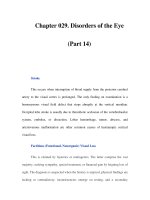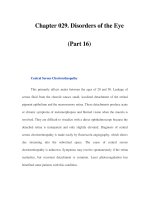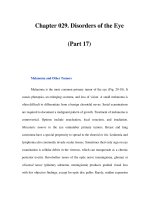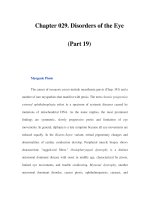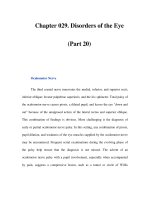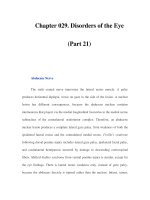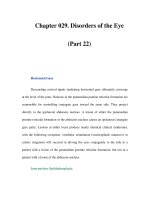Chapter 029. Disorders of the Eye (Part 22) ppsx
Bạn đang xem bản rút gọn của tài liệu. Xem và tải ngay bản đầy đủ của tài liệu tại đây (86.87 KB, 5 trang )
Chapter 029. Disorders of the Eye
(Part 22)
Horizontal Gaze
Descending cortical inputs mediating horizontal gaze ultimately converge
at the level of the pons. Neurons in the paramedian pontine reticular formation are
responsible for controlling conjugate gaze toward the same side. They project
directly to the ipsilateral abducens nucleus. A lesion of either the paramedian
pontine reticular formation or the abducens nucleus causes an ipsilateral conjugate
gaze palsy. Lesions at either locus produce nearly identical clinical syndromes,
with the following exception: vestibular stimulation (oculocephalic maneuver or
caloric irrigation) will succeed in driving the eyes conjugately to the side in a
patient with a lesion of the paramedian pontine reticular formation, but not in a
patient with a lesion of the abducens nucleus.
Internuclear Ophthalmoplegia
This results from damage to the medial longitudinal fasciculus ascending
from the abducens nucleus in the pons to the oculomotor nucleus in the midbrain
(hence, "internuclear"). Damage to fibers carrying the conjugate signal from
abducens interneurons to the contralateral medial rectus motoneurons results in a
failure of adduction on attempted lateral gaze. For example, a patient with a left
internuclear ophthalmoplegia will have slowed or absent adducting movements of
the left eye (Fig. 29-19). A patient with bilateral injury to the medial longitudinal
fasciculus will have bilateral internuclear ophthalmoplegia. Multiple sclerosis is
the most common cause, although tumor, stroke, trauma, or any brainstem process
may be responsible. One-and-a-half syndrome is due to a combined lesion of the
medial longitudinal fasciculus and the abducens nucleus on the same side. The
patient's only horizontal eye movement is abduction of the eye on the other side.
Figure 29-19
Left internuclear ophthalmoplegia (INO). A. In primary position of gaze
the eyes appear normal. B. Horizontal gaze to the left is intact. C. On attempted
horizontal gaze to the right, the left eye fails to adduct. In mildly affected patients
the eye may adduct partially, or more slowly than normal. Nystagmus is usually
present in the abducted eye. D. T2-weighted axial MRI image through the pons
showing a demyelinating plaque in the left medial longitudinal fasciculus (arrow).
Vertical Gaze
This is controlled at the level of the midbrain. The neuronal circuits
affected in disorders of vertical gaze are not fully elucidated, but lesions of the
rostral interstitial nucleus of the medial longitudinal fasciculus and the interstitial
nucleus of Cajal cause supranuclear paresis of upgaze, downgaze, or all vertical
eye movements. Distal basilar artery ischemia is the most common etiology. Skew
deviation refers to a vertical misalignment of the eyes, usually constant in all
positions of gaze. The finding has poor localizing value because skew deviation
has been reported after lesions in widespread regions of the brainstem and
cerebellum.

